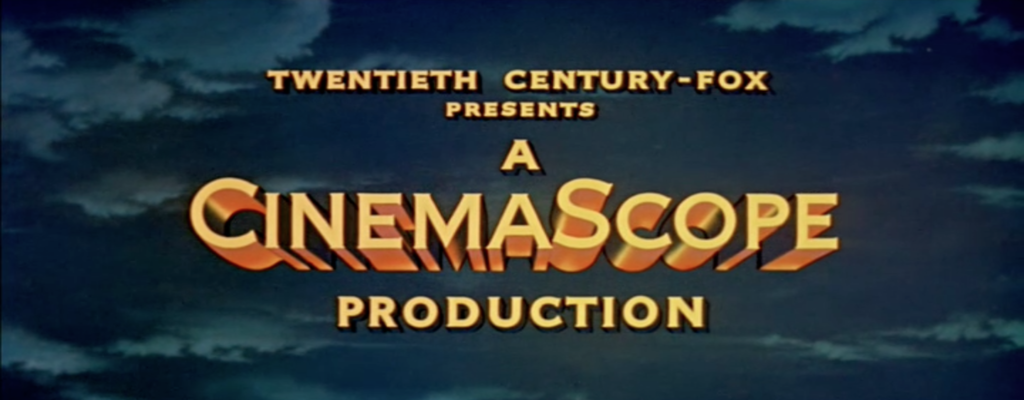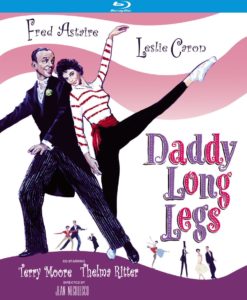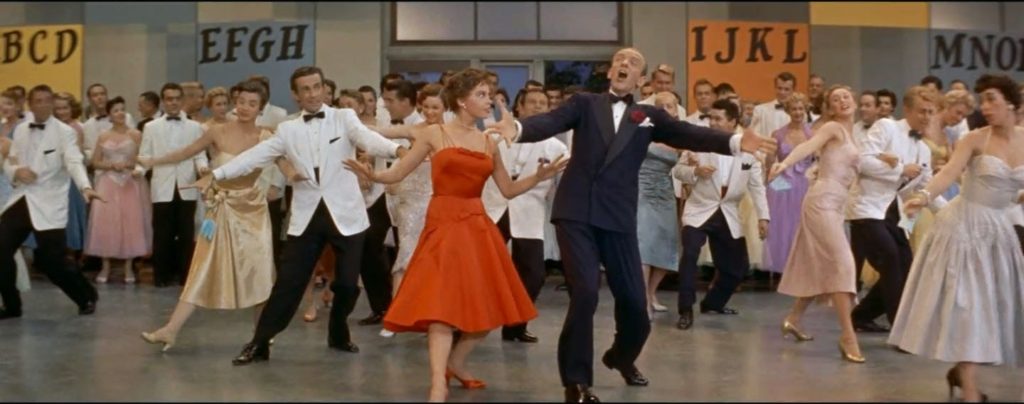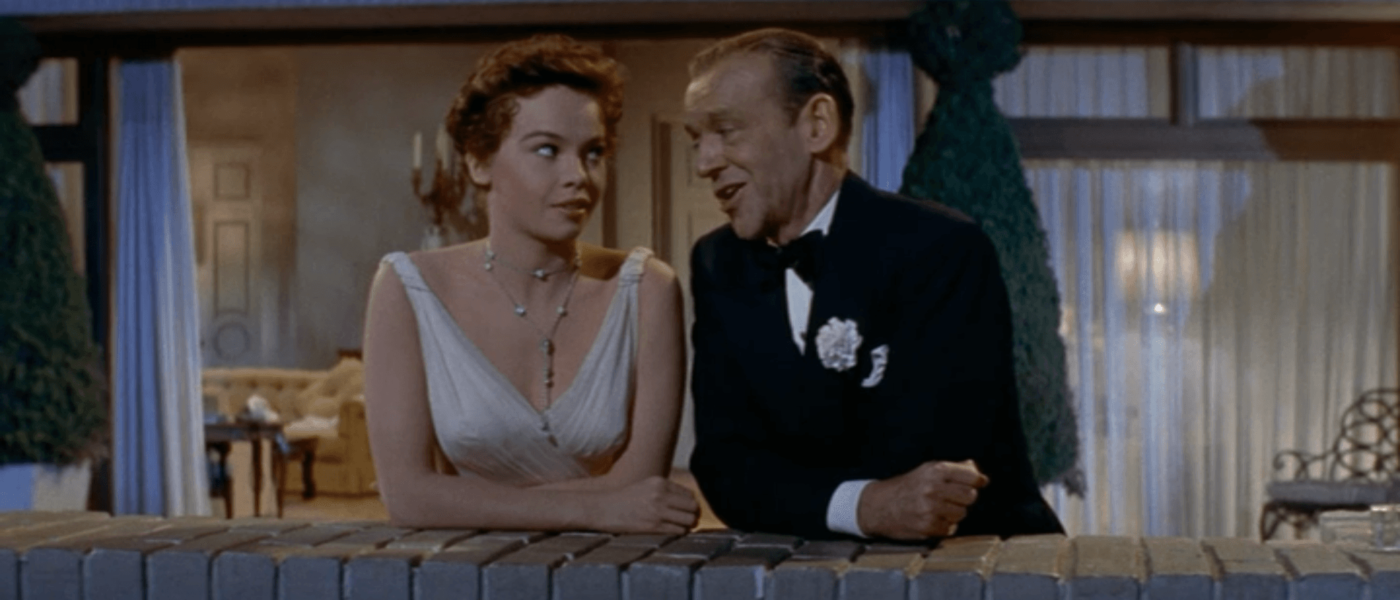Glorious Technicolor, Breathtaking CinemaScope, And Stereophonic Sound!
DIRECTED BY JEAN NEGULESCO/1955
STREET DATE: September 6, 2016/KINO LORBER

 Although you’d somehow have to substitute “color by DeLuxe” and “4-Track Stereo” into the gently parodying Cole Porter lyric quoted above, from Fred Astaire’s subsequent musical Silk Stockings (1957), it is also an accurate description of the long-limbed performer’s first widescreen musical. Daddy Long Legs, made in 1955 for Twentieth Century-Fox, was shot in the “breathtaking” visual format of CinemaScope; which, with its “curved”-edgings and “flattened”-rectangular screen dimensions – a “2.55:1” screen aspect ratio for all you tech-heads out there – remains, even in this day of widescreen televisions, stubbornly ill-fitted to one’s home video screen.
Although you’d somehow have to substitute “color by DeLuxe” and “4-Track Stereo” into the gently parodying Cole Porter lyric quoted above, from Fred Astaire’s subsequent musical Silk Stockings (1957), it is also an accurate description of the long-limbed performer’s first widescreen musical. Daddy Long Legs, made in 1955 for Twentieth Century-Fox, was shot in the “breathtaking” visual format of CinemaScope; which, with its “curved”-edgings and “flattened”-rectangular screen dimensions – a “2.55:1” screen aspect ratio for all you tech-heads out there – remains, even in this day of widescreen televisions, stubbornly ill-fitted to one’s home video screen.
But that, of course, was entirely the point. In order to draw moviegoers back to theaters, studio executives felt that movies in 1955 had to offer something which their more small-scale home-viewing competitor could not. With Fred Astaire, co-star Leslie Caron, dependable studio stylist Jean Negulesco, photography by Leon Shamroy, songs by Johnny Mercer, ballet by Roland Petit, script by Henry and Phoebe Ephron, and a well-worn screen property filmed before in 1919 (with Mary Pickford) and 1931 (with Janet Gaynor) – one feels one could add another verse to Porter’s song detailing a super musical’s artistic contributions as well as its technical specifications – Daddy Long Legs was the sort of mid-50s “attraction” designed to fill theater seats. And while the film largely succeeded in its day, audiences of today might have an altogether different view of the sights, sounds, and colors of this late-entry screen musical.
The tale of a young French orphan, Julie Andre (Leslie Caron), and a mysterious benefactor whom she knows only as “Daddy Long Legs” (Astaire as wealthy American philanthropist Jervis Pendleton III) eventually finds musical screen comedy love blossoming between the two characters – thanks to complicated plotting, sophisticated dialogue, and fantasy singing-and-dancing dream sequences – despite their 30-year age difference. (Indeed, back when aging screen idols like Gary Cooper and Clark Gable were frequently paired with much younger actresses such as Audrey Hepburn or Grace Kelly, Daddy Long Legs is one of the few movies of the era to directly address any such age difference; uncomfortable though the notion may still seem today.)
Most successful during individual sequences mixing a variety of dance-styles with witty scoring – the film’s first big musical number involves Caron’s character wondering who her rich sponsor might possibly be, with Astaire performing in different guises as a broad comic hoofer, a “dangerous” tango dancer, and, finally, a ballet-dancing “guardian angel” – the songs and dances, effective as they individually are, seem curiously few and far between in the film’s 126-minute running time, and eventually seem to be overtaken by the dialogue and plot which, while also effective on their own, increasingly do not lend themselves well to the more seamless demands of the screen musical. In this regard, then, the de rigueur post-An American in Paris (1951) extended ballet that climaxes the film – a form which Astaire had very successfully incorporated as the famous “Girl Hunt” sequence into his previous musical, The Band Wagon (1953) – here seems almost tacked-on, with Astaire relegated for a full 12 minutes as a mere onlooker to the Leslie Caron-danced, Roland Petit-choreographed, elaborately fantasy-designed goings-on.
But, ultimately, these are mere quibbles. And, one should add, understandable quibbles: as the informative feature-length commentary by film historian and musicals expert Ken Barnes, conversing with Astaire’s daughter Ava Astaire McKenzie, makes clear, the Hollywood musical was in a state of decline in the mid-1950s – victim of changes in popular taste – and Astaire himself would only make three more screen musicals in his career. For a performer like Astaire, the “clear line” of both his performance style and the straightforward appeal of his most successful musicals – from his earliest Art Deco fantasies with Ginger Rogers such as Top Hat (1935) and Shall We Dance (1937) to his later Technicolor dreams with Judy Garland and others in Easter Parade (1948) and Royal Wedding (1951) – was possibly blurred by over-elaborate distraction (Technicolor! CinemaScope! Stereophonic Sound!) from the screen-direct qualities which had so excited audiences from Astaire’s first screen appearances a full 22 years earlier in Dancing Lady and Flying Down to Rio (both 1933). In many respects, the slow decline of the genre was not so much that musicals increasingly relied on a more elaborate presentation to capture an audience’s attention, but rather that no single performer of the caliber of Gene Kelly, Judy Garland, or, indeed, Fred Astaire would emerge to take their screen musical-commanding places. In the awkward post-classic musical shuffle, then, studios somehow lost sight of what to do with their greatest singers and dancers when they actually had them.
Admirable and entertaining as this DeLuxe Color, Cinemascope, 4-Track Stereo production is – and Kino Lorber has here given the film its best possible home video presentation, with a clear and crisp picture and a soundtrack that preserves its multi-directional aural qualities – Daddy Long Legs ultimately comes off as a fairly decent, solid mid-1950s screen effort that nonetheless fails to fully capitalize on its greatest asset: particularly, a virtuoso, screen-charismatic dancer – in an elegant single-take and in a head-to-heels long-shot – gliding effortlessly in front of the camera.

The images used in the review are present only as a reference to the film and are not meant to reflect the actual image quality of the Blu-ray.


